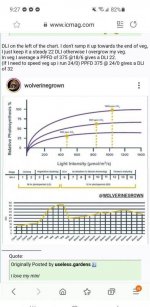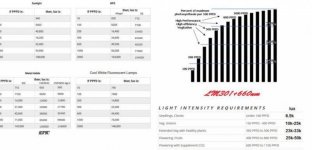stickyunderwear
Member
I found a ebay deal last summer on a Apogee MQ-500 and have been trying to put it to use measuring light levels for plants. I find that a PAR of about 125-150 does well for starting cuts under a dome. Its also a HLG QB-96 4K same as mom box.
My bonsai moms in 5" square pots in my mom area is 12" deep by 36" and a overall height of 26" lined with reflective material. The light is a HLG QB-96 (3"x24") on a dimmable Meanwell driver. About 10-12" from light where the top of the moms get before I trim them back the PAR is around 300 dead in the middle of the light and tapers down to 100+ moving to the end of the cabinet. This seems to work well for the moms since I really dont want them to grow very fast and Im going to lower it some to keep them going but hope to just keep them healthy but not growing too fast. I have 9 strains of bonsai moms.
My main light is a few years old Cree 3590 cob kit from Timber Grow lights. 12" below light in the middle of the fixture the reading with the Apogee reads 1250 on full power. I have a red supplemental kit I put together of 660 Cree chips (small ones) and that will boost it up to 1350. I turn on the additional 660 reds when I flip to flower and usually turn the main light down a smidge.
Some plants like all the light I can give but I have recently started a grow of Ice Cream Cake that I had to turn the light down. Have not measured it yet waiting to see if the plants like that level.
Im interested if more people are taking readings and trying to make use of the info. I understand all lights will give different readings but I would imagine they are similar for the most part.
My bonsai moms in 5" square pots in my mom area is 12" deep by 36" and a overall height of 26" lined with reflective material. The light is a HLG QB-96 (3"x24") on a dimmable Meanwell driver. About 10-12" from light where the top of the moms get before I trim them back the PAR is around 300 dead in the middle of the light and tapers down to 100+ moving to the end of the cabinet. This seems to work well for the moms since I really dont want them to grow very fast and Im going to lower it some to keep them going but hope to just keep them healthy but not growing too fast. I have 9 strains of bonsai moms.
My main light is a few years old Cree 3590 cob kit from Timber Grow lights. 12" below light in the middle of the fixture the reading with the Apogee reads 1250 on full power. I have a red supplemental kit I put together of 660 Cree chips (small ones) and that will boost it up to 1350. I turn on the additional 660 reds when I flip to flower and usually turn the main light down a smidge.
Some plants like all the light I can give but I have recently started a grow of Ice Cream Cake that I had to turn the light down. Have not measured it yet waiting to see if the plants like that level.
Im interested if more people are taking readings and trying to make use of the info. I understand all lights will give different readings but I would imagine they are similar for the most part.
Last edited:



 .
.
